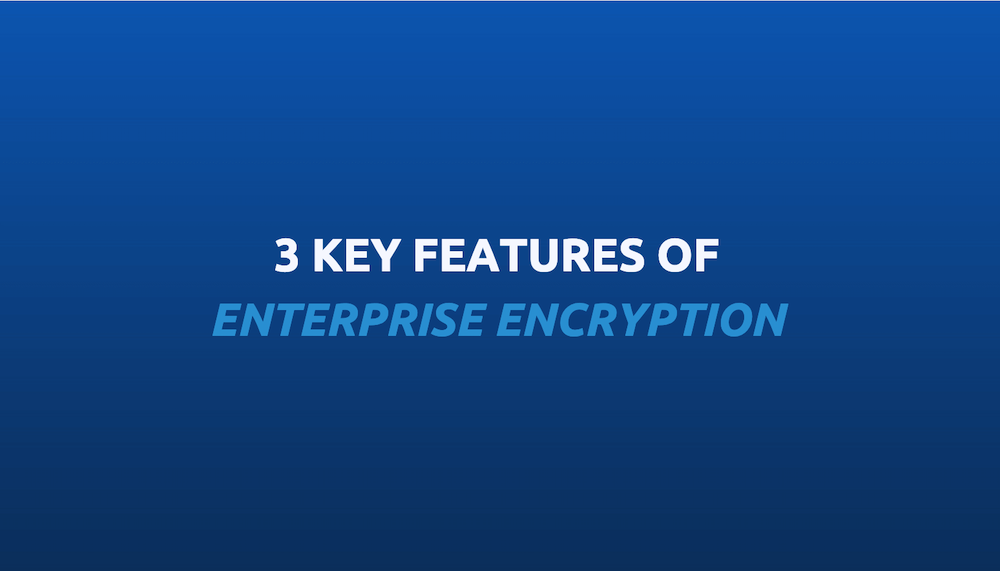Enterprise Encryption: 3 Key Features for Robust Security

Looking to secure corporate assets? From the technical reliability standpoint, the most important and fundamental method is through encryption. Organizations should utilize quality encryption technology to protect the general integrity of their data, and secure critical data from potential information leakage caused by attacks at the ICT infrastructure.
In this post, we go over three key features that should be on the checklist of every business that wishes to effectively protect its assets using encryption solutions.
1. Encryption
An effective encryption solution is a must for every enterprise, but before delving into the specifics: what is encryption? Encryption refers to the mathematical process of changing information into incomprehensible characters using algorithms. The core of current encryption technologies is the encryption key, which is a parameter that specifies the transformation from plaintext (data given before encryption) to ciphertext (a cryptogram, or encrypted data), and vice versa.
Whereas other security tools (e.g. firewalls) protect a system from intrusion or attack, encryption is a fundamental form of defense that deals with the security of the data itself. As such, even in the event of a system breach, compromised data is still only readable by authorized users in possession of the right encryption keys.
In theory, encryption should be appropriately implemented in all three layers of the IT system (i.e. the application, system and network layers) in order to be effective. But in application, the location for encryption implementation and the characteristics of data should be determined based on the performance, management, and security needs of each organization. Options in terms of methods are many, and can be differentiated based on the encryption targets, from file-level encryption that encrypts individual files in their entirety, to more selective encryption of data, such as column-level encryption, for faster performance.
While encryption is an indispensable part of enterprise data protection strategy, selecting the optimal implementation method can be challenging. Encryption solutions are most often available as hardware appliances or via cloud, depending on customer needs. Personalized consultation with the technology vendor is key to finding the most suitable option for each environment and ensuring that encryption needs are adequately addressed.
2. Key Management
Encryption alone is not enough to keep sensitive data safe. This is due to the decisive role of keys in the encryption process. In the event of a data breach, if keys are stored locally within the same server as the encrypted data, hackers would have access to the data and also be able to decrypt it. Similarly, if the keys were mishandled or lost, then it would be the same as if the data were lost as well. As such, secure key management is an essential part of enterprise encryption strategy.
There are numerous opportunities for key mishandling that can cause data loss or leakage, from key generation to destruction and revocation. In today’s digital corporations where data is managed across several platforms, endpoints, and environments, it is highly advisable to focus on eliminating any possibility of key compromise.
The most convenient way to securely control keys throughout enterprise data storage systems is with a key management system, or KMS. A KMS guards the entire key lifecycle and provides the generation, deletion, management, and integration of encryption keys. The keys are stored separately in the management system, while the encryption module provides the cryptographic operations. Many organizations opt to deploy key management in the form of an on-premise hardware appliance, which provides the highest level of physical security out of alternative integration methods (e.g. cloud or SaaS).
3. Access Control and Audit
While organizations tend to prioritize efforts to block external threats, it is equally important to prevent any rogue insiders from exploiting their access to sensitive corporate data. Access control refers to the use of permissions, permission inheritance, user rights, and auditing to effectively guard access to data. In practice, that would include the ability to set access and permission by user, control access to the key management server by accessing server IP, and control the issuance and verification of authentication keys, for example.
Access control is an essential part of corporate security and control, and it can be implemented by allowing different degrees of access to resources based on authority, rank, or other specifications. While encryption solutions generally include access control, specific features may differ between models.
In addition to managing who can access what, all access history should be efficiently retrievable if necessary. Auditing helps reinforce corporate security by allowing administrators to check the audit logs for any suspicious or abnormal activity. To support regular audits, it is recommended to choose an encryption solution that comes with a user-friendly log management tool.
As a final reminder: most security breaches occur due to poor security administration, caused by the unrealistic expectations of a security tool’s capabilities. The only way to prevent such incidents is by improving security consciousness across the user group, and ensuring that security measures within the organization are maintained and utilized as advised by the technology provider.
Looking for a more detailed overview of encryption? See our page on encryption technology and its use in various environments and learn more.